The natives were shot for fun, their hands were cut off, they were boiled alive. For years, no one believed that the famous story "Heart of Darkness" was based on facts. And the colonial reality was even more brutal. However, there were people who took up the fight against cruelty.
Joseph Conrad became famous in the world as the author of the literary masterpiece "Heart of Darkness", the most frequently reissued book in Great Britain, school reading in Poland, on the basis of which several noteworthy films were made, including the already cult film by Francis Ford Coppola. The story of the book takes place in a Belgian colony at the turn of the 20th century and shows the atrocities that Europeans committed against indigenous people with impunity. For years, "Heart of Darkness" in schools and universities was discussed in isolation from the historical context, metaphorically, as if escaping from the awareness that the story presented in its pages really happened, and its main, feral anti-hero Kurtz, was modeled on real living people. As it turns out, the reality was even more nightmarish than Conrad's literary vision…
Complex sovereign and ambitious explorers
The lands of the African Congo entered the sphere of interests of the King of Belgium, the infamous Leopold II in the 1880s, as a result of the sensational discoveries of the traveler Henry Morton Stanley. During his several-year journey, saturated with adventures, he discovered the enormous basin of the Congo River, filling the white spots on the maps of the black continent with dozens of places igniting the imagination and greed. Following the example of almost all the rulers of Europe at that time, Leopold Ludwik Filip Maria Wiktor of the Coburg dynasty wanted to cut himself a piece of the "African cake". But the Belgian wanted this cake only for himself. His distant people scattered around the world, lobbying all major nations in favor of Leopold's plans. The then political system was favorable to these intentions.
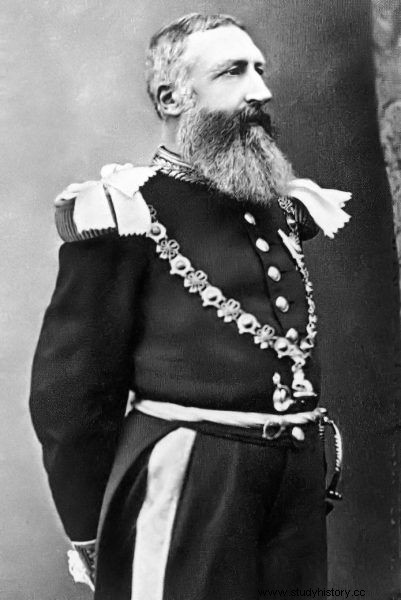
Leopold II has the blood of millions of victims on his hands
In the end, the Belgian monarch financed another Stanley's expedition to establish research outposts in Congo as the seed for a future fief. Of course, research issues or philanthropic slogans of bringing the torch of civilization to poor primitive savages, as well as the establishment of organizations such as the International African Association, the Upper Congo Research Committee, and the International Congo Association were façade activities. The King of Belgium didn't care about the African people, he wanted money.
Finally, in 1885, after a long international conference in Berlin, during which Central Africa was divided by the colonial powers, an enormous amount of land fell into Coburg's private hands. Territories, 76 times the size of Belgium, began to be brutally exploited almost immediately, which was a huge tragedy for the natives. The renaming of the leopold lands as the Congo Free State and the organization of the Anti-Slavery Conference in 1889 under the auspices of the King of Belgium were an expression of far-reaching cynicism and perfidy.
The first commercial bases were quickly established and soon grew into cities, incl. Léopoldville (today's Kinshasa, the capital of the Congo), the port of Boma and dozens of others. The biggest problem was the transport of goods through the Congo River rapids near its mouth, so the foundations for the railway began to be built, avoiding a wide arc of the problematic obstacle.
Ivory was the Congo's main export at the time. Leopold II intended to strip his entire colony of it. To do so, nothing could stand in his way. The standard of the then colonial powers was to treat the natives:Indians, Indians, Eskimos, Africans as people of inferior category. Sometimes they were not found to have human features at all, and in many cases they were treated as part of the fauna that could either be subordinate or would be wiped out. The Germans were in the lead, the British or the Americans were no worse, but King Leopold and his Congolese masters were extremely ruthless.
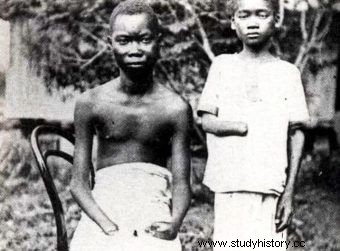
The cut off hands of the natives have become a symbol of the crimes in the Congo…
From the very beginning of their presence in Africa, they began taking masses of people captive, burning entire villages, looting tribes from livestock, and punishing any signs of insubordination with death. Special militia units of the Force Publique made up of Africans, led by Europeans, were set up to enforce the new law. Units were formed from members of hostile tribes, which only increased their ruthlessness. The functioning of the Congo has been compared by many authors to concentration camps and Soviet gulags, or more broadly - to totalitarian systems with their terror, a system of informers, overwhelming control, paramilitary schools and a developed system of punishments and torture. However, in Africa it was much worse.
Regardless of age, sex and physical condition, despite diseases and wounds, everyone had to work to death. Most slaves became porters, indispensable in any endeavors in the jungle. In the mid-1990s, the annual demand for porters amounted to 50,000 people. Entire groups also worked on the construction of the railway. In this case, thousands of deaths were recorded monthly. The exhausted slave simply died in the bushes, left to his fate. For this reason, soon the dead began to litter the entire Congo. At the same time, the news spread to the public in Europe about the Congo Free State drew the new colony as a paradise on earth, the epitome of humanitarianism and philanthropy.
Cut hands and piles of corpses
Year by year, the situation in Congo started to escalate. Most of the colony governors, officers or representatives of other commercial companies no longer see people in the Congolese. Hundreds of archival materials remaining after that period, mainly in the form of letters, diaries, reports, memoirs and photographs show that the lives of the natives were of no value. For example, natives were shot for sport.
One of the officers, a certain René de Permentier, stationed in the mid-1890s in the equatorial region, had all the brush cut around his house so that he could shoot random passers-by from the porch. When a slave raiding the yard left at least one leaf on the lawn (let me remind you that the thing happens in the jungle!), he murdered a total of ten women. However, when the path running through the forest was not properly maintained, he had the first child killed. Other white Europeans have come up with even more elaborate ways of promoting civilization, such as boiling people alive, tying naked natives to trees or bamboo stakes for the day, chopping off heads, tongues, ears, noses, hands and whipping chicotte - a whip made of dried hippo skin. An administrator sentenced a group of children to be flogged for having the audacity to laugh while playing in front of him.
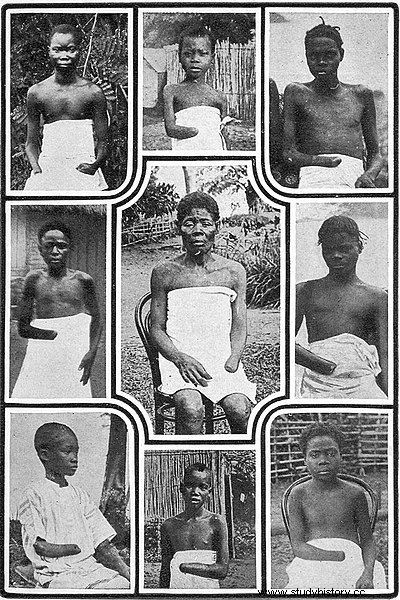
Crippled children of the Congo
But it was the severed, smoked black hand that became the symbol of terror. Everyone's hand was cut off under any pretext, so that after a few years Africa was swarming with cripples. The hand also served as evidence. Each member of the Force Publique was given a certain number of rounds. One cartridge was equal to one killed. In order for the unit commander to be sure that his subordinates did not waste ammunition, e.g. in hunting, he ordered to show himself the hands that had just been cut off.
The Force Publique also consisted of slaves, often malnourished or starving, so it was no wonder that at times they risked using the ammunition for purposes other than execution, and at times they missed. To avoid punishment, they cut off the hands of innocent people alive, smoked them and gave the commanders macabre gifts with baskets, often thousands of them,. Many messages say that heads were also welcome.
How the discoverer of the rubber inner tube contributed to the agony of millions of Africans
Expansion of the colonial administration, enslavement of subsequent tribes, the murderous effort of porters, among whom the death rate was over 50%, increasing hunger, disease, constant humiliation, inhuman treatment ... It was all on the agenda in Leopold II's Congo. rulers, deaf to the screams of millions. Successive expeditions deep into the interior took countless lives. However, this was only the entrance to hell that the colonial administration was to prepare for the natives.
In 1888, a Scottish veterinarian patented a rubber inflatable bicycle inner tube. The discovery has become a giant powerhouse for the tire industry. Rubber began to be used not only for bicycles, and later for car tires, but also for cable insulation, waterproof coatings and many others. For the production of the raw material, rubber was necessary, and it so happened that in Congo, rubber vines grew on huge stretches of jungle, so they were available in unlimited quantities at your (slave's) fingertips. The machine started immediately. Leopold was all the more determined because at the same time the demand for ivory was falling and he had to go as far as to save the business with massive loans. He quickly became a millionaire by harvesting rubber.
To collect the rubber, you had to climb a tree, cut a suitable vine and pour the juice into a vessel. Then it had to be slightly dried and delivered to the collection point. It sounds quite simple, but in the Congolese reality nothing was as the newspapers in favor of the King of Belgium wrote about it. The Africans did not want to risk climbing high, so they had to be forced.
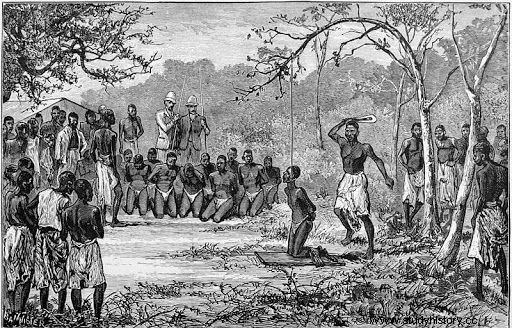
The extraction of rubber has brought another wave of suffering in the Congo, Belgium.
Entire villages were locked up in makeshift pens, forcing men to work. When they refused to work, their wives and mothers were raped, and whole families were murdered. Therefore, they had the incentives to collect the raw material. This is not the end. Each village was obliged to make a minimum standard of rubber. When it was not filled, the collectors were punished with whips and deprived of their diets, as did the hostages. The hunger was exacerbated by the fact that the unemployed farmland lay fallow and overgrown, and the entire inventory of the natives was commandeered by the colonists. It was like a chain reaction. Weakened organisms were more susceptible to disease, the more so that Europeans brought with them variants of influenza previously unknown in Africa.
Deprived of food, the sick organism was not efficient, which made the mortality even greater than before. This, however, did not interest any of the managers. Africans were sent deeper and deeper into the jungle, decimated by sadism of officers and governors, plagues and famine. At the same time, steamers sailed in an uninterrupted stream between the mouth of the Congo and the European continent, carrying precious rubber and ivory. In the opposite direction, thousands of rifles and ammunition were transported, as well as various trash that served as Congolese currency:scraps of fabric, beads and shredded copper wire.
Emissaries of Justice
Among the bestiality of the Belgian Congo management, cynicism and the hypocrisy of the rest of the civilized world, there were fortunately people who were not indifferent to the fate of Africans, and most importantly - they saw them as people, not devils, vermin or monkeys, as many wrote about them in many memoirs.
Edmund Dene Morel was a journalist of Anglo-French descent who, working in the offices of Elder Dempster, a transport company between the Congo and Europe, came across disturbing documents that, in exchange for huge amounts of Congo rubber and ivory, to The Africans sailed on steamboats loaded with ammunition, rifles, and virtually worthless knick-knacks that served as payback. Morel's private investigation showed that the Congolese received virtually nothing in return for their work, ergo - murderous slavery reigns in the Belgian Congo.
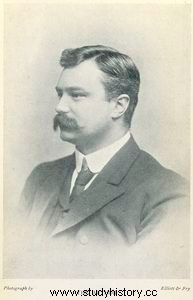
Edmund Dene Morel
Morel could not remain silent about such crimes, so he put all his effort into discrediting the activities of Leopold II in the eyes of the world. It was a duel of David and Goliath. Luckily, the journalist was not alone. Morel was quickly heard about by Roger Casement, Her Majesty's Consul in Congo, who published a comprehensive, macabre report on the Belgian colony in the early twentieth century. The duo founded the Congo Reform Society in 1904, which was supported by many of the world's leading politicians and people of culture. Each week they published articles, leaflets, and press releases about the truth about Leopold's business in Africa. Moreover, Morel, extremely prolific in terms of literary activity, published fat books in which he contained descriptions of crimes smuggled out of the Congo, supported by physical photos.
The actions of these two benefited - the world finally saw Leopold II's humanitarianism in practice. The shock and scandal did not, however, lead to any specific action. Only a moral scandal was supposed to undermine Coburg's position.
A minor prostitute and rivers of blood
King Leopold made an unimaginable fortune in the ivory and rubber trade. Every now and then in Belgium he founded more palaces, triumphal arches, parks, monuments, which he then generously donated to Belgium. He was adored in his country, but the face of an intelligent and charismatic ruler collapsed when his passionate romance with a mere 16-year-old prostitute named Caroline was revealed. This shocked the countrymen who immediately turned their backs on him. Only the rest of the world waited for such a scandal.
Caricatures began to appear across the continent and in the United States, portraying Leopold in many very compromising situations. The Belgian was responsible for fairness, bribing editorial offices and journalists to publish articles defamatory of other countries. Manipulating and blackmailing politicians, people of the pen, was the order of the day, and the heads of churches, both Protestant and Catholic, were also involved, polarizing society even more. At the height of these journalistic wars, Leopold decided in 1904 to set up a subordinate commission made up of judges from Italy, Belgium and Switzerland who went to the Congo. The testimony of hundreds of witnesses shocked the commission, and as a result, the planned ruse was counterproductive - the apparent investigation turned into a real one. While listening to the testimony of some Africans, members of the commission sobbed, others took their own lives.
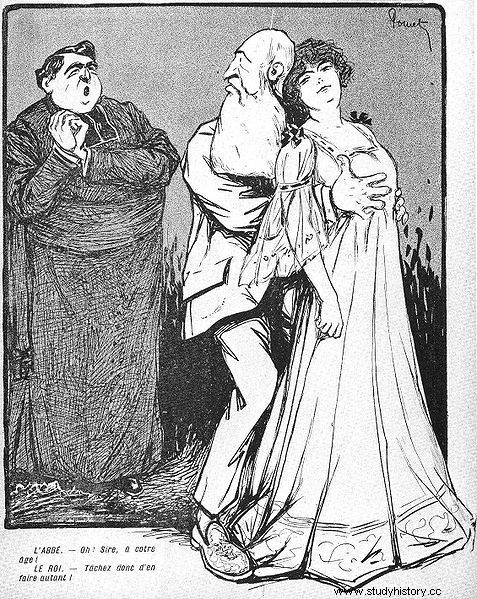
A caricature ridiculing Leopold II and his affair with a minor prostitute
In 1908, Leopold relinquished control of the Congo. According to his will, the Congo Free State passed into the hands of Belgium. It would be naive to think that the lives of the natives have improved since then, as they continued to be cruelly abused, as in other African colonies. Even the liberation of the country from the hands of Europeans in the 1960s did not stop the shedding of innocent blood.
Bill
Before the arrival of the Europeans, it is believed that the area covered by Leopold was inhabited by some 20 million people. Some sources put a figure that is five million more. As a result of murder, starvation, and disease, the population of the Congo halved between approximately 1884 and 1908. This means that Leopold II has over 10 million innocent people on his conscience. For comparison, about 6 million Jews died in German concentration camps during World War II.
Despite this, Leopold II Koburg is not placed in the pantheon of the greatest criminals of the 20th century, and his heirs and the Belgian government have never felt responsible for this genocide, nor have they issued any official apologies. To this day, in history textbooks, the times of Leopold II are recognized as a period of great economic and cultural growth in Belgium as if the screams of millions of victims from another continent did not reach the gilded palaces of Brussels.
Unfortunately, other countries, considered to be the vanguard of civilization, drawing full handfuls from the benefits of exotic colonies were deaf to this call of suffering.
Bibliography:
- Conrad J., Heart of Darkness, Vesper 2009
- English Ch., Book smugglers from Timbuktu, Wydawnictwo Poznańskie 2018
- Hochschild A., The Spirit of King Leopold, World of Books 2012
- Osterhammel J., History of the 19th century. Transforming the world, Wydawnictwo Poznańskie 2013
